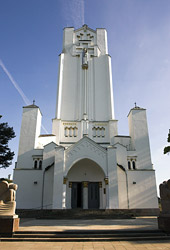Apparition Chapel
To honour the place where Mary had appeared, Catholics at first built a wooden chapel. The eve of the 300th anniversary of the apparition brought the construction of a new chapel, designed by architect Antanas Vivulskis (1877-1919). Prelate Jonas Mačiulis-Maironis (1862–1932) blessed the cornerstone for that current chapel in 1912. The chapel building, somewhat damaged during World War I, was completed and dedicated in 1924. However, work to furnish and decorate it continued throughout the first period of independence and, secretly, also during the Soviet occupation. The plans of the chapel’s architect were realized fully only in 1999 with the erection near the chapel’s entrance of a second stone angel sculpture by the artist Robertas Antinis (whose father, also Robertas Antinis, had created the first angel sculpture there).
The Apparition Chapel rises to a grandiose height of 44 meters (about 145 feet). Inside stands an altar built over the rock of the apparition, and above the altar is a statue of the Blessed Virgin Mary. The altar is roughly in the centre of the chapel and can be approached from all sides. In fact, many pilgrims circle the altar on their knees as a way to implore God’s graces. The chapel’s walls are embellished with frescos showing the most significant historical events at Šiluva: the baptism of the Samogitian people (in 1413 in the Dubysa Valley), the apparition of the Blessed Virgin, the unearthing of the chest with the valuables of the old church, and the crowning of the miraculous image of Our Lady. Stations for the Seven Sorrows of Mary were put up in the chapel in 1933 and are known as “Mary’s little pathways”.








